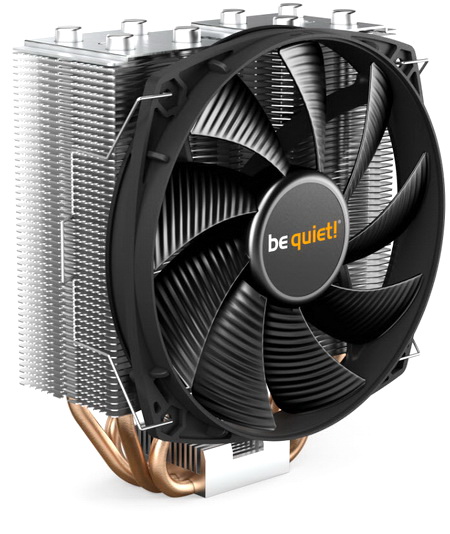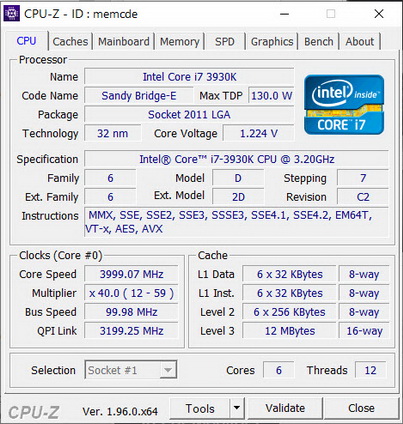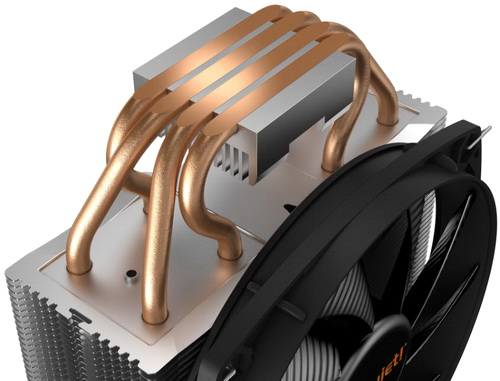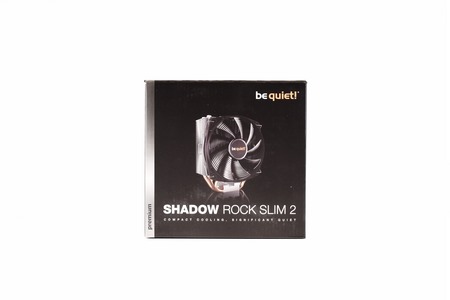INTRODUCTION

Improving on an already popular and successful product is nothing new, manufacturers have been doing that forever and why not since it's basically a recipe for certain success? Yes, sometimes at the end of the day consumers are getting nothing better really than the original product but even that is not a bad thing, not when an entirely new product could underperform in comparison. Just like with most manufacturers around be quiet! is also no stranger to that entire process and so almost 7 years after the release of their original Shadow Rock Slim model (review here) they just released the updated 2.0 version (more accurately the Shadow Rock Slim 2 model) which landed on my desk earlier this month.
be quiet! is a premium brand of power supplies, PC cases and cooling solutions for desktop PCs. The products of be quiet! offer legendary quiet operation and first-class performance thanks the passion for quality and precision. Attention to detail is the key to perfection. Which is why our very own experts lead product conception, design and quality control from our headquarters in Germany. be quiet! sticks to its name: More than 15 years’ experience in the field of noise reduction and silence make be quiet! products probably the most silent ones on the market.
So, what I’m certain most of you out there will be wondering is what exactly did be quiet! change after 7 years? Well, not much to be honest. Both the Shadow Rock Slim and Shadow Rock Slim 2 share the same TDP (thermal design power) of 160W, dimensions (161x137x74mm), number of heatpipes (four 6mm all-copper ones) and the same SilentWings 135mm rifle-bearing fan (BQ SIW3-13525-MR-PMW / 1400RPM). Still be quiet! did introduce three key differences (at least visible/stated ones), total cooler weight (roughly 735g for the Shadow Rock Slim and 685g for the Shadow Rock Slim 2), number of aluminum fins (52 for the Shadow Rock Slim and 53 for the Shadow Rock Slim 2) and base type (nickel plated one for the Shadow Rock Slim and HDT - heatpipe direct touch - for the Shadow Rock Slim 2). Now whether or not these additions/changes will have an impact in performance is something we'll find out later in this review.
SPECIFICATIONS AND FEATURES

PACKAGING AND CONTENTS
Just like with most CPU coolers by be quiet! the Shadow Rock Slim 2 gets shipped inside a black box that has a large product picture at the front next to the company logo.
For more information about the product just scan the 2D barcode located on the left side of the box with your smart phone or tablet.
The specifications table is printed on the right side of the box right over the cooler's TDP and beneath a few words about be quiet!.
Moving at the rear we find two pictures used to showcase the main product features.
Packing is not the best I’ve seen but it did get the job done.
Be quiet! ships the Shadow Rock Slim 2 with 4 fan clips (2 for the thin bundle fan and 2 for a regular thickness fan), small thermal paste tube, Intel backplate, mounting bar, user manual, warranty information paper and mounting sets for both Intel LGA 1150/1151/1155/1156/1200/2011/2011-3/2066 and AMD AM3/AM3+/AM4 motherboards.
THE SHADOW ROCK SLIM 2
The 540g heavy heatsink of the Shadow Rock Slim 2 stands 161mm tall, 130mm wide and 52mm long.
Tiny details like the be quiet! logo and the heatpipe covers on the top brushed aluminum plate always matter.

 This time over be quiet! has squeezed 53 aluminum fins in the heatsink.
This time over be quiet! has squeezed 53 aluminum fins in the heatsink.
Once again however we see four 6mm thick all-copper heatpipes (this design ensures zero-clearance issues with motherboard components).
The new Shadow Rock Slim 2 features an H.D.T (heatpipe direct touch) base just like the Pure Rock 2 model reviewed a while back.
As mentioned earlier the 135mm SilentWings rifle-bearing fan is identical to that used with the first Shadow Rock Slim (1400RPM/67.8CFM/23.7dBA).
Aside their specially designed blades which increase airflow these fans feature a vibration-absorbing rubber ring.
With the bundled SilentWings fan attached the Shadow Rock Slim 2 now measures 137mm in width and 74mm in thickness.
TEST BED


TESTING METHODOLOGY
We always take things quite seriously when it comes to work so just like with the previous LGA1366 database we will not be testing each CPU Cooler on its own and with different ambient temperature levels and thus we can actually have yet another valid CPU Cooler database. Testing a CPU Cooler automatically means that you need to know where it stands against the immediate competition and to accomplish that we have spent both money and time through the years, something that we plan to continue to do so in order to get the most accurate results for the end consumers who read these lines. Every CPU cooler in this database is tested with the bundled 140mm/120mm/92mm/80mm fans while working at both idle speed and 100% of their speeds for all the temperature tests. CPU Coolers that do not come bundled with a fan/s are measured using a Noctua fan (size dependent on the model) to test for the temperature tests but due to the lack of a stock fan dBA level tests are obviously skipped. Single (120/140mm) watercooling solutions are tested with the radiator mounted at the rear of our test rig while dual/triple/quad (240/260/280/360/420/480/560mm) solutions with the radiator mounted at the top. For the dBA tests every cooler in the database was measured both while on idle mode or with the fan controller in the minimum setting and while on extreme load or with the fan controller all the way to the highest possible setting (PWM fans do that on their own without our intervention). Every single test takes place in a temperature controlled room of 23 degrees Celsius Ambient Temp with the help of two AC units placed diagonally inside the room. The Noctua NT-H1 thermal paste is used with every CPU Cooler in our latest LGA2011 database (although initially this was not the plan, we had to change things to get the most accurate results). Finally, it's very important to point out that just because a CPU Cooler is better than another when tested with our test rig that does not necessarily mean that the same performance differences will apply 100% for other CPU models and in other situations (such as different ambient temps and system configurations).
To successfully record the load temperatures, we use the latest OCCT application for around 6-10 minutes to push the processor to its limits and after that is done and the temperatures are recorded, we wait for about 10-20 minutes for the CPU to cool down and record the idle temperatures. This is done to allow time for the thermal conductive material to achieve the optimal performance level. Same procedure is then repeated with the Passmark BurnIn Test as a failsafe just in case the OCCT results are wrong. This procedure is more time consuming than the usual peltier/thermometer tests but this way not only can we deliver real world results to our readers based on real CPUs but we can also triple check the results using a variety of programs. Last but not least the temperatures were recorded using both the latest versions of AIDA64 and RealTemp while the noise level tests are performed using a high precision ExTech HD600 Decibel Meter placed about 10-15cm above the CPU Cooler. Still although the same testing procedure applies to all units do take into consideration that unlike the official numbers which are measured in special noise isolated labs with just the fans here, we also have both the rest of the cooler and the rest of the system (although all system fans are turned off when recording noise levels).
TEST RESULTS


CONCLUSION

When the Shadow Rock Slim 2 CPU cooler by be quiet! arrived in the lab i didn’t have very high hopes for it. Sure, it’s been 7 years since the release of the first Shadow Rock Slim model but simply put the addition of a single extra fin and an H.D.T base just didn’t feel important enough. Still results speak for themselves and so the new Shadow Rock Slim 2 outperforms its predecessor by a good margin. Yes, it still can’t compete with larger models but the fact alone that it competes with the cooling efficiency of the Pure Rock 2 says a lot.
The Shadow Rock Slim 2 CPU Cooler by be quiet! was officially released just 2 days ago and so it currently retails for USD45.90 inside the USA (Newegg.com) and for 53.04Euros inside the EU (Amazon.de). This is actually a very good price point for this CPU cooler, especially if you take into account its cooling performance, low noise levels and its zero-clearance feature. Granted it may not be amongst the top CPU coolers in the market today but it offers a very good bang for your buck which is why it also gets the Golden Award.

PROS
- Build Quality
- Very Good Cooling Efficiency
- Low Noise Levels
- Size (Zero Clearance)
CONS
- None

 O-Sense
O-Sense




















.png)

